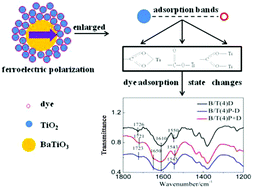Changes of the dye adsorption state induced by ferroelectric polarization to improve photoelectric performance†
Abstract
Coupling ferroelectric materials with semiconductor materials can improve the performance of photovoltaic cells. The BaTiO3/TiO2(n) (B/T(n)) photoanode of dye-sensitized solar cells (DSSCs) is composed of a BaTiO3 core, a high performance and frequently-used ferroelectric material, and TiO2 nanoparticles, a common semiconductor material. A hysteresis loop, 105 μC cm−2 remnant polarization and 7 kV cm−1 coercive field of the photoanode demonstrate its ferroelectricity. The short-circuit current density (Jsc) of the dye-sensitized photoanode after polarization (B/T(n)PD) is superior to that of unpolarized (B/T(n)D) by about 2 mA cm−2, regardless of the direction of polarization. The DSSC based on the B/T(4)PD photoanode exhibits a power conversion efficiency (PCE) of 7.29% and a Jsc of 14.44 mA cm−2. Reflectance spectroscopy, Fourier transform infrared spectroscopy (FTIR) and intensity modulated photocurrent/photovoltage spectroscopy (IMPS/IMVS) are carried out to investigate the light absorption, charge injection and separation processes in B/T(n). Spontaneous polarization changes the adsorption state of the dye, which increases the light absorption efficiency, electron injection efficiency, incident light to photocurrent efficiency (IPCE) and Jsc. The discovery reported in this paper provides a method for modulating the interaction of adsorbed molecules with solids by means of electric field changes. This study deepens the understanding of the mechanism of charge transport and photovoltage generation in photovoltaic cells.



 Please wait while we load your content...
Please wait while we load your content...